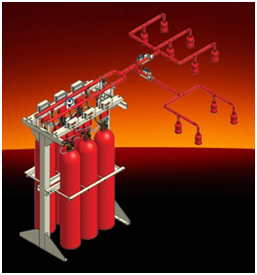Carbon dioxide may be stored as a liquid in high pressure containers. The liquid temperature in this case is subjective to variance with ambient temperature. It also may be stored in refrigerated containers at storage temperature of -18 °C (0 °F). Due to the effect of temperature reduction on the discharge flow rate, the temperatures limit for high pressure systems are between 0 to 49 °C (32 - 120 °F). On the other hand, the temperature drop effect on low pressure systems will not occurs above -23 °C (-10 °F). Extreme climate conditions may impose additional requirements such as winterization in case of high-pressure storage or the use of heaters with circulation pumps in case of low-pressure storage. Carbon dioxide has white cloudy appearance because of the fine dry ice particles discharged with vapor. Additional fog will be created during carbon dioxide discharge due to condensed water vapor. The discharged dry ice particles can carry static discharges as well as the ungrounded discharge nozzles. Hence; to avoid shock hazard or the presence of static discharge in explosive atmosphere, all discharge nozzles must be grounded. Carbon dioxide is denser than air. This helps in replacing air above burning surfaces and maintaining a smothering effect when used in local application systems. Carbon dioxide regulate the breathing of a human. The breathing rate increase with the increase of carbon dioxide percent in blood up to a concentration of 7% in air. The breathing rate then drop down with the increase of carbon dioxide percent in air. At a carbon dioxide percent in air between 17 to 30%, breathing stops immediately. Since the minimum design concentration of carbon dioxide in air to extinguish fire exceed the threshold point of 7%, the design of safety precautions is mandatory into every carbon dioxide extinguishing system. Carbon dioxide extinguish fires either by smothering or by cooling. The ability of carbon dioxide to extinguish Class A fires is limited by its relatively low cooling capacity and by the enclosures ability to maintaining extinguishing atmosphere. Carbon dioxide can easily extinguish surface burning fires. On the other hand, deep seated burning fires may require higher concentration and much longer holding time for complete extinguishment. Some deep-seated fires cannot be extinguished at all using carbon dioxide even after along hold time period. In such case, carbon dioxide may be used to suppress open flaming and slow the propagation of fire. This process shall extend until the intervention of a properly equipped and trained fire brigade take place. Carbon dioxide may be applied by discharging enough quantity into an enclosure to create an extinguishing atmosphere which is called total flooding. Another method is to apply it directly into the burning material without any reliance on the enclosure which is called local application. Other methods such as hand hose lines, standpipe systems and mobile supply, extended discharge and special applications are also available. NFPA 12, Standard on Carbon Dioxide Extinguishing Systems includes provisions that address life safety when it comes carbon dioxide extinguishing systems. As an example, its prohibited to use total flooding carbon dioxide systems in normally occupied spaces. However, this rule has exceptions. Total flooding carbon dioxide systems can be installed in normally occupied enclosures for fires involving energized electrical equipment greater than 400 volts and grouped electrical cables where no gaseous alternative agent has been successfully tested. Another example, all carbon dioxide systems are required to include lockout valves. As for the alarm, all systems except hand hose line system are required to provide audible and visual pre-discharge alarm. Warning signs must be located outside each entry to total flooding enclosures. Carbon dioxide system components commonly includes the following:
Carbon dioxide containers
Two types of containers are available: high pressure containers and low-pressure containers.
Piping System
It is either sized manually or by computer program to meet NFPA12 requirements for different types of carbon dioxide systems.
Valves and Operating Device
It must be capable of withstanding the maximum operating pressure as well as being bubble tight when closed in addition to being manually and automatically operated.
Discharge Nozzles
They are either high velocity or low velocity nozzles.
System Controls
Systems incorporate three types of controls: automatic operation, normal manual operation and emergency manual operation.
Control Panel
Detectors and manual pull station are connected to this panel in modern carbon dioxide systems. Pulling a manual station or triggering detectors will activate the audible and visual alarm through the panel. NFPA12 requires pneumatic pre-discharge time delays and pneumatic pre-discharge alarms to be incorporated into most carbon dioxide systems retroactively.
Alarm
Generally, audible and visual alarms are required in most carbon dioxide systems.
All previously discussed systems and components are provided by Bavaria to satisfy the customers' needs. Please check our products technical datasheets for more information or contact us.

